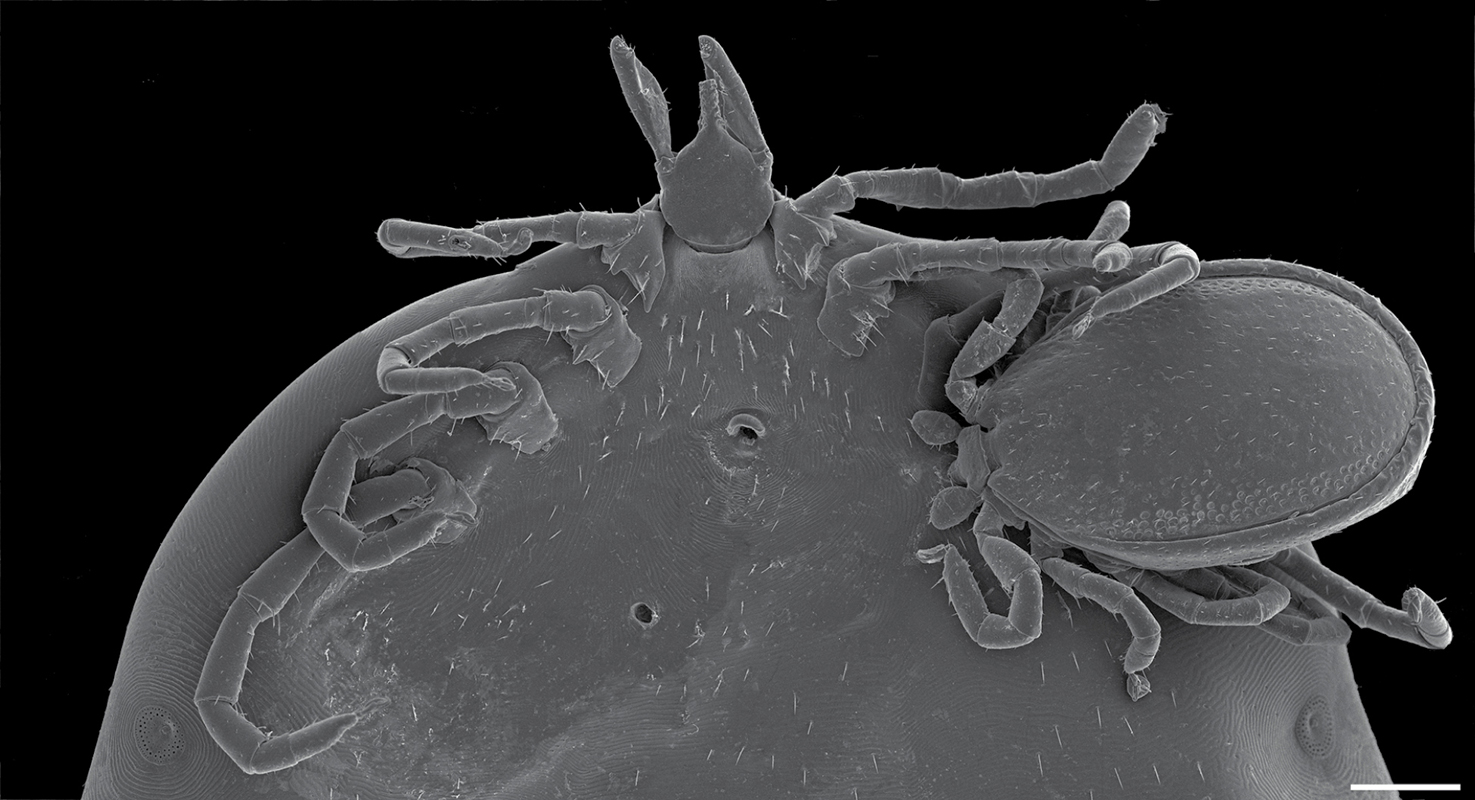Tick Bites Tick! Tiny Male Puts the Bite on an Engorged Female

Researchers conducting a tick survey in Alaska unexpectedly found themselves looking at an unusual tick pic.
A tiny adult female tick that had been removed from a red squirrel was carrying her own parasitic hitchhiker — an adult male of the same tick species, Ixodes angustus — and he appeared to be gripping the female not in the throes of passion, but of hunger.
When scientists examined the blood-engorged female using a scanning electron microscope (SEM), they identified the much smaller male tick clinging to and feeding from the underside of the female's body, digging in deep with its piercing mouthparts. [Bloodsuckers! Michigan Ticks and Larvae, in Photos]
Blood-feeding ticks in the genus Ixodes are in the family Ixodidae, and are hard-bodied (the other main family of ticks, Argasidae, is soft-bodied). Hard ticks have three life stages — larva, nymph and adult — and the insects typically take one blood meal from a host during each stage, according to the Department of Entomology and Nematology at the University of California, Davis.
The tick species I. angustus has been associated with the spread of Lyme disease, and is the species that is the most abundant on rodents and other mammals in British Columbia and Alberta, both provinces in Canada, and in Alaska, researchers from Georgia Southern University, the Alaska Department of Environmental Conservation, and the Alaska Department of Fish and Game, wrote in a new study describing the evidence of tick-on-tick feeding.
By feasting on another tick, the male insect described by the study authors was practicing a behavior known as hyperparasitism — when parasites cut out the middleman by skipping over the host animal entirely and cadging a meal directly from their blood-bloated fellow parasites.
A second male tick was also attached to the female and was mating with her, but it became dislodged as the researchers prepared the specimens for scanning, they wrote in the study.
Sign up for the Live Science daily newsletter now
Get the world’s most fascinating discoveries delivered straight to your inbox.
The remaining male tick's mouth parts penetrated the female's body region close to her head and genital opening, and his palps — a pair of elongated appendages near his mouth — were splayed upon her exoskeleton, positioned in a characteristic feeding pose, the scientists noted.
And the male in the image likely wasn't the only hitchhiker that had fastened himself to the female for a free lunch. An additional scar on her body — a small puncture visible below and to the left of her central genital opening — suggested that another hungry tick also fed on the female, the researchers reported.
Hyperparasitism is common in soft ticks, but was thought to be less widespread in their hard-bodied cousins, and has not been previously detected in the hard tick species I. angustus. However, prior research has not only documented male ticks in the Ixodes genus parasitizing females, but has also recorded evidence of feeding scars on females like those found in the new study. That evidence, along with the new findings, suggests that male hard-bodied ticks may use females as a meal ticket more frequently than once thought, the authors concluded.
The findings were published online Feb. 19 in the Journal of Medical Entomology.
Original article on Live Science.

Mindy Weisberger is an editor at Scholastic and a former Live Science channel editor and senior writer. She has reported on general science, covering climate change, paleontology, biology and space. Mindy studied film at Columbia University; prior to Live Science she produced, wrote and directed media for the American Museum of Natural History in New York City. Her videos about dinosaurs, astrophysics, biodiversity and evolution appear in museums and science centers worldwide, earning awards such as the CINE Golden Eagle and the Communicator Award of Excellence. Her writing has also appeared in Scientific American, The Washington Post and How It Works Magazine. Her book "Rise of the Zombie Bugs: The Surprising Science of Parasitic Mind Control" will be published in spring 2025 by Johns Hopkins University Press.









